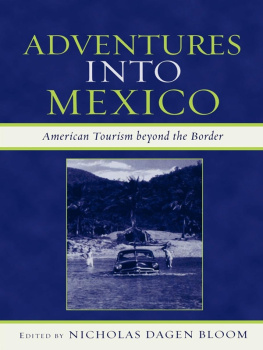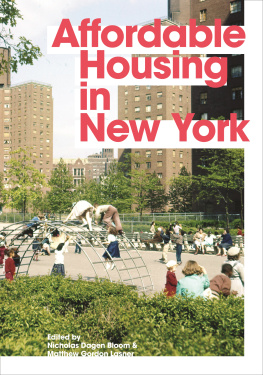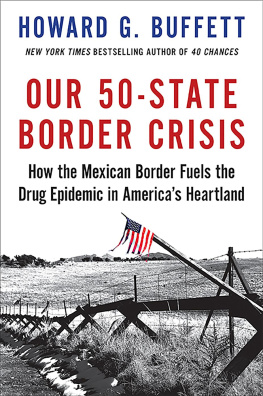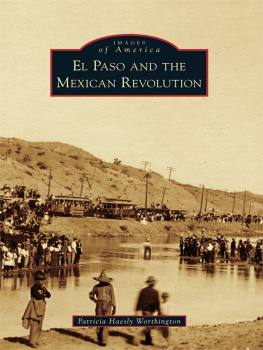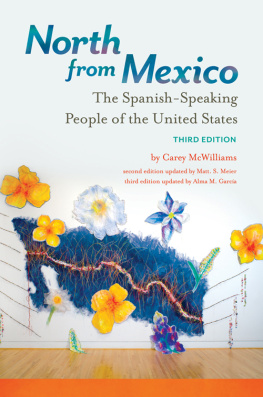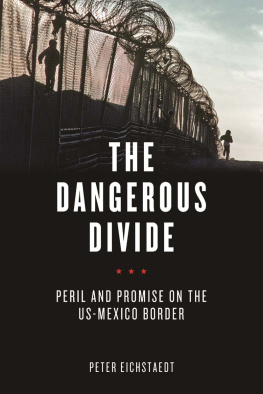I would like to thank Colin MacLachlan and William H. Beezeley for lending their wise editorial guidance over the years. All of my contributors have been patient too, enduring the stately development of the collection.
Susan McEachem at Rowman and Littlefield proved to be a responsive editor for a project inherited from Scholarly Resources Press. Bridgette Moore guided the project through publication, and the copyediting skills of John Shanabrook brought clarity to our prose.
The New York Institute of Technology has been a pleasant academic home for the past two years, and I thank the faculty and administration for their continuing support. Gerri Brown provided timely and accurate retyping of certain published materials. I would like to thank Archer Press and the University of Texas Press for permission to republish sections of previously published books.
My parents charming descriptions of their misadventures and joys in San Miguel de Allende made me consider Mexico a potential travel destination in the first place. Adventures into Mexico with my wife, Leanne Bloom, ultimately inspired this book project, but words can never convey the thrill we felt as we wandered into yet another stunning Mexican city.
Further Reading
Historical research that treats Americans in Mexico includes Diana Anhalt, A Gathering of Fugitives: American Political Expatriates in Mexico, 19481965 (Santa Maria, Calif.: Archer, 2001); Deborah Baldwin, Protestants and the Mexican Revolution: Missionaries, Ministers, and Social Change (Urbana: University of Illinois Press, 1990); William H. Beezley, Judas at the Jockey Club and Other Episodes of Porfirian Mexico, 2d ed. (Lincoln: University of Nebraska Press, 2004); Janet Bennion, Desert Patriarchy: Mormons and Mennonite Communities in the Chihuahua Valley (Tucson: University of Arizona, 2004); Helen Delpar, The Enormous Vogue of Things Mexican (Tuscaloosa: University of Alabama Press, 1992); Paul Dosal, Doing Business with the Dictator: A Political History of United Fruit in Guatemala, 18991944 (Wilmington, Del.: Scholarly Resources, 1993); Gene Hanrahan, The Bad Yankee: American Entrepreneurs and Financiers in Mexico (Chapel Hill: University of North Carolina Press, 1985); John Mason Hart, Empire and Revolution: The Americans in Mexico since the Civil War (Berkeley: University of California Press, 2002); Robert Herr, An American Family in the Mexican Revolution (Wilmington, Del.: Scholarly Resources, 1999); Tullis F. LaMond, Mormons in Mexico : The Dynamics of Faith and Culture (Logan: Utah State University Press, 1987); Taylor D. Littleton, The Color of Silver: William Spratling, His Life and Art (Baton Rouge: Louisiana State University Press, 2000); Joan Mark, The Silver Gringo: William Spratling and Taxco (Albuquerque: University of New Mexico Press, 2000); David Pletcher, Rails, Mines, and Progress: Seven American Promoters in Mexico, 1867 1911 (Ithaca, N.Y.: Cornell University Press, 1958); Andrew F. Rolle, The Lost Cause: The Confederate Exodus to Mexico (Norman: University of Oklahoma Press, 1965); Ramn Ruiz, The People of Sonora and Yankee Capitalists (Tucson: University of Arizona Press, 1988); and William Schell Jr., In, tegral Outsiders: The American Colony in Mexico City, 1876 1911 (Wilmington, Del.: Scholarly Resources, 2001).
The research on border dynamics is extensive and includes Tom Barry, The Great Divide: The Challenge of U.S.-Mexico Relations in the 1990s (New York: Grove, 1994); Claire Fox, The Fence and the River: Culture and Politics at the U.S.-Mexico Border (Minneapolis: University of Minnesota Press, 1999); Rosa Fregosa, Mexican Encounters: The Making of Social Identities on the Borderlands (Berkeley: University of California Press, 2003); Lawrence Herzog, Where North Meets South: Cities, Space, and Politics on the U.S.-Mexico Border (Austin: Center for Mexican American Studies, University of Texas, 1990); Lawrence Herzog, From Aztec to High Tech: Architecture and Landscape across the Mexico-United States Border (Baltimore: Johns Hopkins University Press, 1999); David E. Lorey, The U.S.-Mexican Border in the Twentieth Century: A History of Economic and Social Transformation (Wilmington, Del.: Scholarly Resources, 1999); Oscar J. Martinez, Border People: Life and Society in the U.S.-Mexico Borderlands (Tucson: University of Arizona Press, 1994); Oscar J. Martnez, ed., U.S.-Mexico Borderlands: Historical and Contemporary Perspectives (Wilmington, Del.: Scholarly Resources, 1996); Jse Saldivar, Border Matters: Remapping American Cultural Studies (Berkeley: University of California Press, 1997); David Spencer, ed., The U.S.-Mexico Border: Transcending Divisions, Contesting Identities (Boulder, Colo.: Lynne Rienner, 1998); and Andrew Grant Wood, On the Border: Society and Culture between the United States and Mexico (Wilmington, Del.: Scholarly Resources, 2004).
For a general introduction to modern tourist theory, see Barbara Kirshenblatt-Gimblett, Destination Culture: Tourism, Museums, and Heritage (Berkeley: University of California Press, 1998); Dennis R. Judd and Susan S. Fainstein, eds., The Tourist City (New Haven, Conn.: Yale University Press, 1999); Dennis R. Judd, ed., The Infrastructure of Play: Building the Tourist City (Armonk, N.Y.: M. E. Sharpe, 2003); Dean MacCannell, The Tourist: A New Theory of the Leisure Class (New York: Schocken Books, 1976); Chris Rojek and John Urry, eds., Touring Cultures: Transformations of Travel and Theory (New York: Routledge, 1997); and John Urry, The Tourist Gaze (London: Sage Publications, 1990).
The origins of tourism are documented in a number of books, including Michael Foss, ed., On Tour: The British Traveler in Europe (London: OMara, 1989), 197. See also Jeremy Black, The British Abroad: The Grand Tour in the Eighteenth Century (New York: St. Martins, 1992) and Black, Italy and the Grand Tour (New Haven, Conn.: Yale University Press, 2003); James Buzard, The Beaten Track: European Tourism, Literature, and the Ways to Culture, 18001918 (New York: Oxford University Press, 1993); Brian Dolan, Ladies of the Grand Tour (London: Harper Collins, 2001); Christopher Hibbert, The Grand Tour (London: Thames Methuen, 1987); and John Stoye, English Travelers Abroad (New Haven, Conn.: Yale University Press, 1989).
American tourism history has also become an active field. See Cindy Aron, Working at Play: A History of Vacations in the United States (New York: Oxford University Press, 1999); Warren Belasco, Americans on the Road: From Autocamp to Motel, 19101945 (Cambridge, Mass.: MIT Press, 1979); Dona Brown, Inventing New England: Regional Tourism in the Nineteenth Century (Washington, D.C.: Smithsonian Institution Press, 1995); Catherine Cocks, Doing the Town: The Rise of Urban Tourism in the United States (Berkeley: University of California Press, 2001); Karen Dubinsky, The Second Greatest Disappointment: Honeymooning and Tourism at Niagara Falls (New Brunswick, N.J.: Rutgers University Press, 1999); Christopher Endy, Cold War Holidays: American Tourism in France (Chapel Hill: University of North Carolina Press, 2004); John Findlay, Magic Lands: Western Cityscapes and American Culture after 1940 (Berkeley: University of California Press, 1992); John Jakle, The Tourist: Travel in Twentieth-century North America (Lincoln: University of Nebraska Press, 1985); Hal K. Rothman, Devils Bargains: Tourism in the Twentieth-century American West (Lawrence: University Press of Kansas, 1998); John F. Sears, Sacred Places: American Tourist Attractions in the Nineteenth Century (New York: Oxford University Press, 1989); Marguerite Shaffer, See America First: Tourism and National Identity, 18801940 (Washington, D.C.: Smithsonian Institution Press, 2001); Richard Starnes, ed., Southern Journeys: Tourism, History and Culture in the Modem South (Tuscaloosa: University of Alabama Press, 2003); and William W. Stowe, Going Abroad: European Travel in Nineteenth-century American Culture (Princeton, N.J.: Princeton University Press, 1994).

